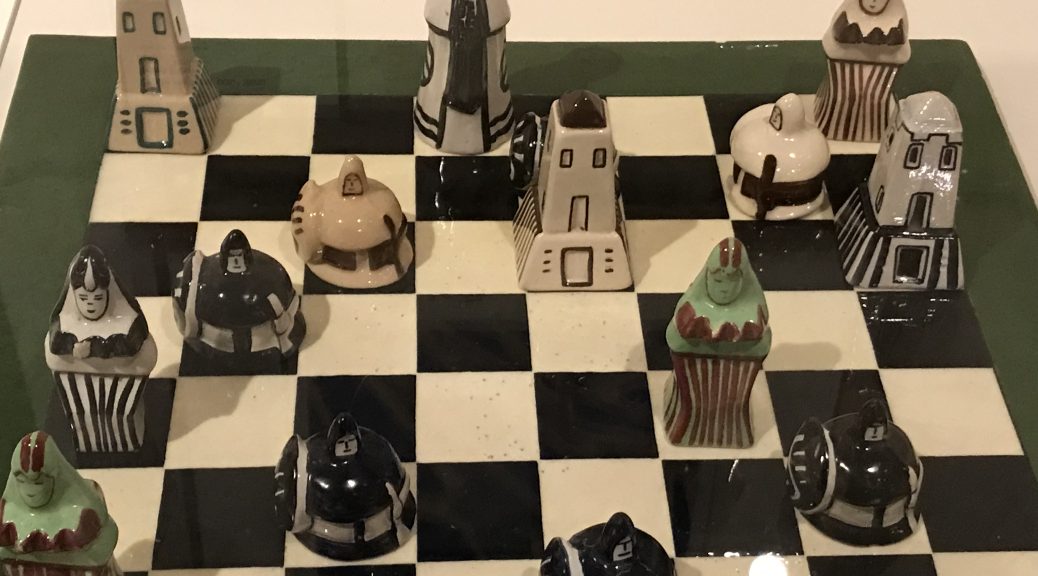This chess set (photo © Jennifer Kilgore-Caradec), produced by Henriot in Quimper during the 1930s, was designed by Jeanne Malivel (1895-1926) and Pierre Abadie-Landel (1896-1972). Jeanne Malivel’s crucial role in creating the Ar Seiz Breur (the Seven Brothers) arts movement in Brittany is celebrated this spring at the Bibliothèque Forney in Paris, in an exhibition devoted to her brilliant but short-lived artistic career of approximately one decade. Her early works feature testimonial sketches of wounded soldiers that she helped to reconstruct—and heal—as a volunteer nurse during World War I. In addition to being an accomplished painter with watercolors and oils, from her studio in Loudéac she also created modernist reconstructions of traditional Breton folk arts through diverse techniques, including engravings, embroidery, ceramics, and Breton Art-Deco furniture design—even to such fine detail as hinges, locks, and keys. Many of these works figured in the room she actively promoted and designed for the Brittany Pavillon, Ty Breiz, at the International Exhibition of Modern Decorative and Industrial Arts in Paris in 1925.
Most of the articles in this number refer to writers active from the time of World War I to the period of high modernism in the 1920s, but the wars discussed range across the twentieth century, through the Cold War, and including the first Gulf War (1991). The thematic idea for this number, as well as a number of contributions, originated at the SAES 2017 in Reims. The Société d’anglicistes de l’enseignement supérieur had chosen as its theme “(re)construction(s)” and, conjugated by the Société d’études modernistes for its first SAES workshop, the notion of “Modernist Reconstructions” emerged. Some of those who participated in the workshop were delighted to discover the stylish architecture of modernist reconstructions that Reims offers, as well as the stained-glass Chagall windows in the Cathedral, with their hue of medieval blue. Readers unfamiliar with the SEM, which co-sponsors this seventh number of Arts of War and Peace, may discover more about the association, founded in 2013, at https://sem-france.org.
Hélène Aji contributed a piece suggesting that the obscenity of World War I unfolds as a kind of psychosis in Ezra Pound’s mind, becoming visible in his poetry as early as 1917, and resulting in a fascist reconstruction within his works. Noëlle Cuny‘s paper focuses on the friendship between H.D. and D.H. Lawrence during the years 1915-1917, her influence on Lawrence’s writing, and the attraction of classical Greek culture for both poets. Nathaniel Davis offers an exploration of language registers and foreign accents as reconstructed in Ernest Hemingway’s For Whom the Bell Tolls. Alexandre Ferrere parses the representations of nuclear war in a poem by Gregory Corso and then Allen Ginsberg’s experiences with sound poetry in a pacifist protest poem composed from 1971 to 1991. Margaret Gillespie‘s paper examines works by Rebecca West and Djuna Barnes, and their portrayals of gender identity, as a counter to more stereotyped representations of women during the period of World War I and the period that followed. Both West and Barnes put forward “a powerful denunciation of the perversion and inhumanity of warfare.” Olivier Hercend turns to Virginia Woolf and James Joyce, showing how they were appalled by violence and how their texts promote introspection about the war and the public discourse and ideology that enabled it. Pauline Macadré examines several novels of Virginia Woolf, finding remnants of violence as a way of re-enacting the reality of war and warn about propaganda, while evoking also Woolf’s own “waste land”.
Two reviews offer other perspectives. Olivier Hercend gives insights for Modernist Objects (2020), edited by Noëlle Cuny and Xavier Kalck. Mathieu Duplay reviews the first performance of Nixon in China at Opéra Bastille in Paris.
There are also new poems by Ron Smith whose collection That Beauty in the Trees will appear in April 2023. Monique Lojkine-Morelec brings a new French translation of T.S. Eliot’s The Waste Land that will be appreciated by students and critics alike. Eliot’s original notes were apparently a kind of farcical addendum to the poem, ensuring in 1922 that the work contained enough pages to be published in an individual volume, and here Lojkine’s detailed notes offer considerable clarity and insight.
In jest, let it also be mentioned that the centennial celebrations for the poem The Waste Land almost coincide with the first decade of Arts of War and Peace. Sylvain-Karl Gosselet, Mark Meigs and I, together with all the contributors for this number, wish you excellent reading.
Jennifer Kilgore-Caradec
ARTICLES
Olivier Hercend
Deconstructing consent: education, ideology and conflict in Jacob’s Room and Portrait of the Artist as a Young Man
Pauline Macadré
The reconstruction of meaning amid “shells, bones and silence”: Woolf’s retrieving of reality among the relics of war
Noëlle Cuny
H.D. and D.H Lawrence, eros and the war
Hélène Aji
Obscene Modernity: Ezra Pound against the Great War
Nathaniel Davis
“That was thinking in Spanish”: Translated Style and Interlingual Strangeness in Hemingway
Margaret Gillespie
Gender and war: modernist reconfigurations in Rebecca West’s The Return of the Soldier (1918) and Djuna Barnes’ Nightwood (1936)
Alexandre Ferrere
Bombs, Shapes and Sounds: A joint analysis of Gregory Corso’s “Bomb” and Allen Ginsberg’s “Hum Bom!”
REVIEWS
Olivier Hercend
Modernist Objects, edited by Noëlle Cuny and Xavier Kalck
Mathieu Duplay
“From Vision to inheritance”: Nixon in China at the Opéra Bastille
CREATION
Ron Smith
Three Poems
TRANSLATION
Monique Lojkine-Morelec
T.S. Eliot, Terre en déshérence / The Waste Land (1922)
